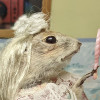New enclosure the culprit?
Last week, I printed this lamp cover successfully. Print direction was “bottom to top” without any support material. Now, the last print of the same cover failed miserably. The main difference is that my Prusa MINI+ now lives within an enclosure so I assume the temperature within the enclosure might be the culprit here. Would love to hear your thoughts on it and I’m sure that you have an idea how to circumvent this situation in my next print.
I used PLA with a nozzle temperature of 200°C and a bed temperature of 60°C.
Looking forward to hear your thoughts ☺️




Add comment